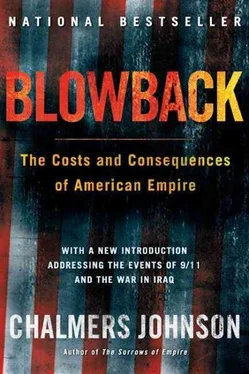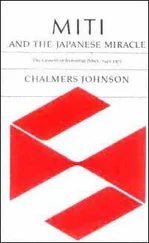Chalmers Johnson - Blowback, Second Edition - The Costs and Consequences of American Empire
Здесь есть возможность читать онлайн «Chalmers Johnson - Blowback, Second Edition - The Costs and Consequences of American Empire» весь текст электронной книги совершенно бесплатно (целиком полную версию без сокращений). В некоторых случаях можно слушать аудио, скачать через торрент в формате fb2 и присутствует краткое содержание. Год выпуска: 0101, ISBN: 0101, Издательство: Macmillan, Жанр: Старинная литература, на английском языке. Описание произведения, (предисловие) а так же отзывы посетителей доступны на портале библиотеки ЛибКат.
- Название:Blowback, Second Edition: The Costs and Consequences of American Empire
- Автор:
- Издательство:Macmillan
- Жанр:
- Год:0101
- ISBN:9780805075595
- Рейтинг книги:5 / 5. Голосов: 1
-
Избранное:Добавить в избранное
- Отзывы:
-
Ваша оценка:
- 100
- 1
- 2
- 3
- 4
- 5
Blowback, Second Edition: The Costs and Consequences of American Empire: краткое содержание, описание и аннотация
Предлагаем к чтению аннотацию, описание, краткое содержание или предисловие (зависит от того, что написал сам автор книги «Blowback, Second Edition: The Costs and Consequences of American Empire»). Если вы не нашли необходимую информацию о книге — напишите в комментариях, мы постараемся отыскать её.
Blowback, Second Edition: The Costs and Consequences of American Empire — читать онлайн бесплатно полную книгу (весь текст) целиком
Ниже представлен текст книги, разбитый по страницам. Система сохранения места последней прочитанной страницы, позволяет с удобством читать онлайн бесплатно книгу «Blowback, Second Edition: The Costs and Consequences of American Empire», без необходимости каждый раз заново искать на чём Вы остановились. Поставьте закладку, и сможете в любой момент перейти на страницу, на которой закончили чтение.
Интервал:
Закладка:
The International Monetary Fund entered this picture and turned a financial panic into a crisis of the underlying economic systems. As already mentioned, the Bretton Woods conference of 1944 had created the IMF to service the system of fixed exchange rates that lasted until the “Nixon shocks” of 1971. It survived its loss of mission in 1971 to become, in the economist Robert Kuttner’s words, “the premier instrument of deflation, as well as the most powerful unaccountable institution in the world.” 14The IMF is essentially a covert arm of the U.S. Treasury, yet beyond congressional oversight because it is formally an international organization. Its voting rules ensure that it is dominated by the United States and its allies. India and China have fewer votes in the IMF, for example, than the Netherlands. As the prominent Harvard economist Jeffrey Sachs puts its, “Not unlike the days when the British Empire placed senior officials directly into the Egyptian and Ottoman [and also the Chinese] financial ministries, the IMF is insinuated into the inner sanctums of nearly 75 developing country governments around the world—countries with a combined population of some 1.4 billion.” 15
In 1997, the IMF roared into a panic-stricken Asia, promising to supply $17 billion to Bangkok, $40 billion to Jakarta, and $57 billion to Seoul. In return, however, it demanded the imposition of austerity budgets and high interest rates, as well as fire sales of debt-ridden local businesses to foreign bargain hunters. It claimed that these measures would restore economic health to the “Asian tigers” and also turn them into “open” Anglo-American-type capitalist economies. At an earlier meeting at Manila in November 1997 called to deal with the crisis, Japan and Taiwan had offered to put up $100 billion to help their fellow Asians, but the U.S. Treasury’s assistant secretary, Lawrence Summers, denounced the idea as a threat to the monopoly of the IMF over international financial crises, and it was killed. He did not want Japan taking the lead, because Japan would not have imposed the IMF’s conditions on the Asian recipients and that was as important to the U.S. government as restoring them to economic health. 16
In Indonesia, when the government ended its dollar peg and let the currency float, the rupiah fell from about 2,300 to 3,000 to the dollar but then stabilized. At that point, with almost no empirical knowledge of Indonesia itself, the IMF ordered the closure of several banks in a system that has no deposit insurance. This elicited runs on deposits at all other banks. The wealthy Chinese community began to move its money out of Indonesia to Singapore and beyond, and the country was politically destabilized, leading ultimately to the overthrow of President Suharto. All Indonesian companies with dollar liabilities rushed to sell rupiahs and buy dollars. Equities instantly lost 55 percent of their value and the currency, 60 percent. The rupiah ended up trading at 15,000 to one U.S. dollar. David Hale, chief economist of the Zurich Insurance Group, wrote at the time, “It is difficult, if not impossible, to find examples of real exchange rate depreciations comparable to the one which has overtaken the rupiah since mid-1997.” He suggested that a proper comparison might be with the hyperinflation that hit the German mark in 1923. 17
By the time the IMF was finished with Indonesia, over a thousand shopkeepers were dead (most of them Chinese), 20 percent of the population was unemployed, and a hundred million people—half the population—were living on less than one dollar a day. William Pfaff characterized the IMF’s actions as “an episode in a reckless attempt to remake the world economy, with destructive cultural and social consequences that could prove as momentous as those of 19th-century colonialism.” 18Only Japan, China, and Taiwan escaped the IMF juggernaut in East Asia. Japan kept aloof even when the Americans publicly rebuked it for failing to absorb more exports from the stricken countries, for the Japanese knew that the Americans would not actually do anything as long as the marines were still comfortably housed in Okinawa. China remained largely untouched because its currency is not freely convertible and it had paid no attention to APEC calls for deregulation of capital flows. And Taiwan survived because it had been slow in removing its financial barriers. It also maintains a relatively low ratio of investment to gross domestic product, is shifting further toward a service economy whose capital needs are less, and has maintained export diversity—unlike, for example, Korea’s overconcentration in products such as semiconductors destined for the American market. Foreign holdings of Taiwanese currency are negligible because its peculiar political status makes it unattractive to the hedge funds. Thus, it has been able to offer some of its own huge foreign currency holdings to help bail out countries in Southeast Asia.
After the big investors had pulled their money out of East Asia and left the area in deep recession, they turned to Russia. They calculated that there was little or no risk in buying Russian state bonds paying 12 percent interest because the Western world would not let a former superpower armed with nuclear weapons default. But the situation was further gone in Russia than these investors imagined, and so, in August 1998, the Russians defaulted on the interest payments (they still owe foreign investors perhaps $200 billion). If Russia does not repay these loans, it will be the largest default in history. These developments so scared the finance capitalists that they started pulling their money in from all over the world, threatening even well-run economies that had implemented all the economists’ nostrums on how to get rich like the North Americans. The Brazilian economy was so destabilized that in mid-November 1998 the IMF had to put together a $42 billion “precautionary package” to shore it up. Needless to say, the IMF has also helped plunge millions of poor Brazilians deeper into poverty. In order to meet the IMF’s austerity requirements, the Brazilian government even had to cancel a $250 million pilot project to save the Amazon rain forest. The result was that other countries withdrew their matching funds for the Amazon, and the degradation of an area that contributes 20 percent of the globe’s fresh-water supply resumed. 19
In speeches in Russia and East Asia during the second half of 1998, President Clinton warned the peoples of these areas not to “backslide” and urged them to open their nations even further to American-style laissez-faire capitalism. But he had lost his audience. By now his listeners understood that the cause of their misery could not also be its cure. Many remembered that the Great Depression started as a financial panic then made worse by deflationary policies similar to those prescribed by the IMF in 1997 and 1998 for East Asia, Russia, and Brazil. The result in the early 1930s was a general collapse of purchasing power. That has not happened so far this time, largely because the United States went on a consumption binge and provided virtually all growth in demand for the excess output of the world. Can American “shop till we drop” be sustained indefinitely? No one knows.
The economic crisis at the end of the century had its origins in an American project to open up and make over the economies of its satellites and dependencies in East Asia. Its purpose was both to diminish them as competitors and to assert the primacy of the United States as the globe’s hegemonic power. Superficially it can be said to have succeeded. The globalization campaign significantly reduced the economic power and capitalist independence of at least some of the United States’ “tiger” competitors—even if, as with Russia and Brazil, the crisis could not be kept within the bounds of East Asia. This was, from a rather narrow point of view, a major American imperial success.
Читать дальшеИнтервал:
Закладка:
Похожие книги на «Blowback, Second Edition: The Costs and Consequences of American Empire»
Представляем Вашему вниманию похожие книги на «Blowback, Second Edition: The Costs and Consequences of American Empire» списком для выбора. Мы отобрали схожую по названию и смыслу литературу в надежде предоставить читателям больше вариантов отыскать новые, интересные, ещё непрочитанные произведения.
Обсуждение, отзывы о книге «Blowback, Second Edition: The Costs and Consequences of American Empire» и просто собственные мнения читателей. Оставьте ваши комментарии, напишите, что Вы думаете о произведении, его смысле или главных героях. Укажите что конкретно понравилось, а что нет, и почему Вы так считаете.










